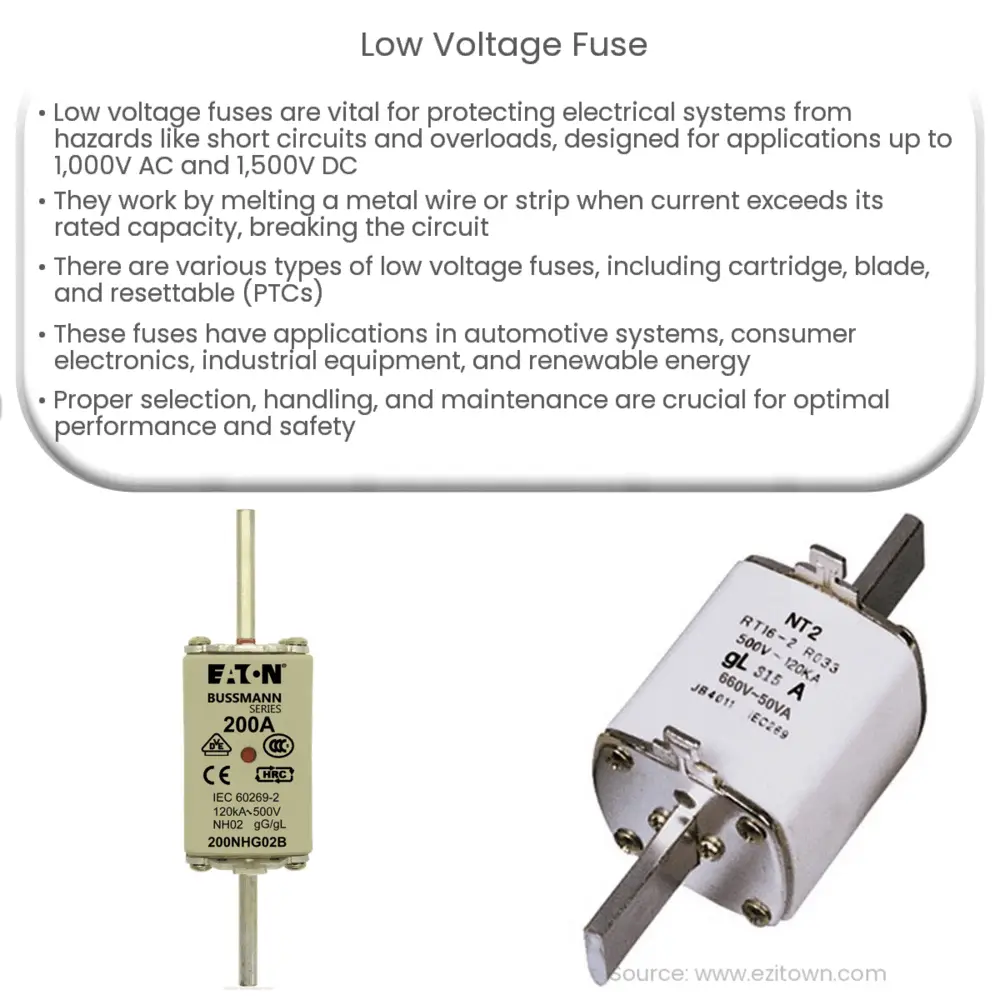Low voltage fuses safeguard electrical systems by interrupting overcurrents, protecting devices from short circuits and overload events.

Understanding Low Voltage Fuses: An Essential Guide
Introduction to Low Voltage Fuses
Low voltage fuses play a crucial role in protecting electrical systems and devices from potential hazards such as short circuits, overloads, and other unexpected electrical events. These fuses are specifically designed for low voltage applications, typically up to 1,000 volts (V) for alternating current (AC) and 1,500 volts (V) for direct current (DC). In this article, we will explore the fundamental concepts, types, and applications of low voltage fuses to provide a comprehensive understanding of their importance in electrical engineering.
Working Principle of Fuses
A fuse is a vital safety component in electrical systems that functions as a sacrificial device to protect against overcurrents. It consists of a metal wire or strip with a low melting point, enclosed in a non-conductive housing. When the current flowing through the wire exceeds the fuse’s rated capacity, the wire’s temperature increases, causing it to melt and break the circuit. This interruption of current flow prevents potential damage to the electrical system and its components.
Types of Low Voltage Fuses
Low voltage fuses come in various types to cater to different application requirements. Some of the most common types include:
1. Cartridge Fuses
Cartridge fuses consist of a cylindrical body with metal end caps, which make contact with the fuse holder. These fuses are available in both fast-acting and time-delay versions, depending on the application. Fast-acting cartridge fuses rapidly interrupt the circuit when an overcurrent occurs, while time-delay fuses allow for a short period of increased current before breaking the circuit, which is useful in scenarios where temporary surges are common.
2. Blade Fuses
Blade fuses are primarily used in automotive applications and feature a flat, blade-like structure that plugs into a fuse holder. These fuses are color-coded according to their current ratings, making it easy to identify and replace them as needed. Blade fuses can also be found in fast-acting and time-delay varieties.
3. Resettable Fuses (PTCs)
Resettable fuses, or positive temperature coefficient (PTC) devices, are a type of self-resetting protection mechanism. Unlike traditional fuses that need to be replaced after interrupting a circuit, PTCs regain their functionality once the fault condition is resolved and the device cools down. These fuses are particularly useful in situations where frequent replacements may be impractical or costly.
In the next section, we will discuss the applications of low voltage fuses, their selection criteria, and some essential safety considerations.
Applications of Low Voltage Fuses
Low voltage fuses find a wide range of applications across various industries and sectors. Some of the most common applications include:
- Automotive systems: Protecting electrical components, such as lighting, radios, and electronic control units, in vehicles.
- Consumer electronics: Safeguarding devices like computers, televisions, and home appliances from power surges and short circuits.
- Industrial equipment: Ensuring the safety of machines, motors, and control systems in manufacturing plants and facilities.
- Renewable energy systems: Protecting components in solar panels, wind turbines, and energy storage devices from electrical faults.
Selecting the Right Fuse
Choosing the correct fuse for a specific application is essential to ensure reliable and efficient protection. Factors to consider when selecting a fuse include:
- Current Rating: The fuse’s current rating should be slightly higher than the normal operating current of the device it is protecting to avoid nuisance tripping.
- Voltage Rating: The voltage rating of the fuse must be equal to or higher than the maximum voltage of the system to prevent electrical breakdown.
- Breaking Capacity: The breaking capacity of the fuse should be higher than the prospective short-circuit current of the system to avoid catastrophic failures.
- Time-Current Characteristics: The time-current characteristics of the fuse should match the specific requirements of the application, considering factors like inrush currents and transient surges.
Safety Considerations
Proper handling and maintenance of low voltage fuses are crucial for ensuring the safety of electrical systems and the people working with them. Some essential safety tips include:
- Always replace blown fuses with ones of the same type and rating to avoid compromising the protection level of the system.
- Use appropriate personal protective equipment (PPE) when working with or near electrical systems, including safety goggles, gloves, and insulated tools.
- Regularly inspect and maintain fuse holders and connections to prevent loose contacts, overheating, and other potential issues.
- Follow the manufacturer’s guidelines and industry standards for the installation, operation, and maintenance of fuses and related components.
Conclusion
Low voltage fuses are an indispensable component in safeguarding electrical systems and devices from potential hazards. Understanding the different types, applications, selection criteria, and safety considerations is vital for engineers, technicians, and end-users alike. By implementing proper fuse selection and maintenance practices, you can ensure the reliable operation and protection of your electrical equipment and systems.

